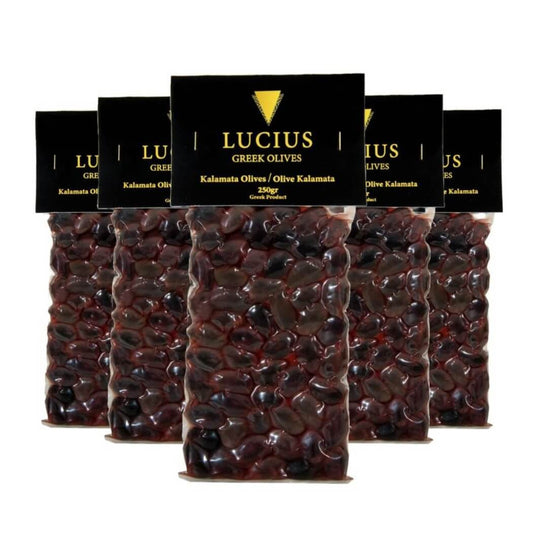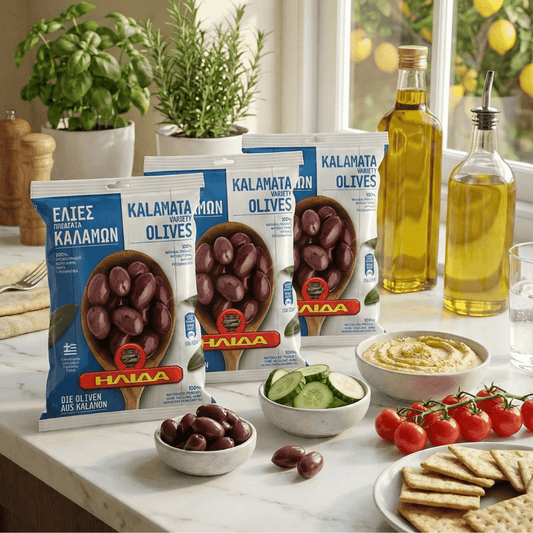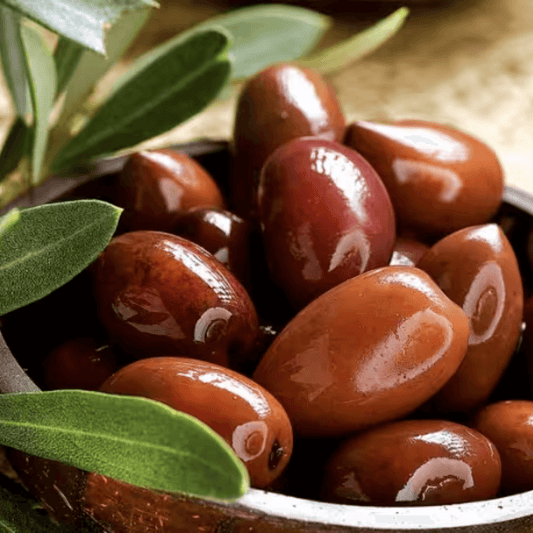
Greece with its Mediterranean climate is the perfect home of the olive tree. Local and regional climatic differences and soil conditions have led to ever new varieties of olives in Greece. That is why there are many varieties of Greek olives today.
There are now over 60 different types of olives. Each variety has its own character. The olive varieties in Greece differ not only in size, color and shape, but also in the composition of their ingredients and thus in taste.
Kalamata olives are almond shape and have a brown deep purple color. They are found on the Peloponnese peninsula in southern Greece and have played a role in human nutrition for thousands of years. The olive trees grow under the amazing Greek sun and have much larger leaves than other types of olive trees around the nation and the world.
The fruits of this variety are called Kalamata olives only if they actually come from the region, as it is a protected designation of origin.
City of Kalamata and its olives

The olive tree has existed for thousands of years and is believed to have originated in the eastern Mediterranean. The olive tree is a symbol of honor and culture and has even been used as a prize for champions at the Olympic Games. Olives have been a food since the early Minoan era. These small black fruits are not only a staple in Greek cuisine, but also in international varieties.
Popular for their nutritional properties and healthy fat dose, Kalamata olives of the Kalamon variety are named after the Messinia region in the Peloponnese, where they are also made. However, they are also harvested in the neighboring area of Laconia.
Known for their almond shape, deep purple color and intense flavor, Kalamata olives are hand picked to avoid bruising. After harvesting the olives, the workers either process them into olive oil or prepare them into table olives.
Their optimal harvest time is late fall, while other varieties are usually picked earlier, which explains why they are still green. If the olives are too green, the fruit, along with the olive oil produced, will taste bitter. On the other hand too dark means low quality.
During harvest, the workers place the mesh nets under the trees to collect all the fruit while the branches are shaken.
Harvest of Kalamata olives

As mentioned earlier, Kalamata olives are hand picked in early October. The time of harvest of the fruit not only determines the size of the fruit and its quality, but also the content of health-promoting ingredients.
Despite their purple color and size, they are often classified as black table olives, while they can also be used to make olive oil. Like most olives, they are inherently bitter, which is why they are usually cured or processed before consumption.
At this stage of ripeness, the water content of the olive is still low, which affects its firmness and thus its quality. However, the fresh fruits are not yet edible and are immediately placed in brine.
This process is known as the "hardened" process and is used to improve their taste.
There are two different ways to do this.
- The short way, is to soak the olives in brine for a week, which increases their sodium content. Then the workers pack them with brine, wine vinegar, lemon wedges, and olive oil.
- The long way is to make a slit in each olive and store them in 10% salt water for fermentation until they turn bitter. This process usually takes about three months.
Kalamata olives and their effects

Black olives are considered by doctors and nutritionists to be one of the healthiest foods in the world, and that's because they're high in sodium, high in healthy fats, and a natural antioxidant.
Kalamata olives contain a number of health-promoting vitamins and minerals and are particularly rich in iron and vitamin A. Regular consumption is said to reduce the risk of cardiovascular disease and various types of cancer.
Kalamata olives have been linked to a variety of health benefits due to their high content of potent beneficial botanicals.
The olives are said to have the following effects:
- Protect the cardiovascular system
- Protect the nerve cells from damage
- Improve skin health
- Reduce the risk of heart attacks
- Reduce the bad LDL cholesterol
- Stimulate your metabolism
- anti-cancer properties
- Antimicrobial and antiviral effects
Kalamata olives vs Black Olives

Origins: Kalamata olives are a black variety of olives. They are one of the most popular Greek olive varieties that grow in Messinia, a regional unit in Greece. The olives are named after the city of Kalamata, near which they were grown.
Black olives also come from the Mediterranean area. They were first cultivated over five thousand years ago. Today many countries are involved in their production due to their climate - not only Greece, but also the USA, Australia, etc.
Appearance : You can easily distinguish between Kalamata olives and black olives. Kalamata olives are this deep purple in color.
Kalamata olives are also more elongated and almond-shaped, while black olives are more rounded. Black olives also come in many different shapes.
Curing method: After the harvest, the olives go through a so-called "hardening process". Kalamata and black olives are cured differently.
Taste: Both Kalamata and black olives are bitter when first picked.
The taste of Kalamata olives is unique and more pronounced than the taste of many varieties of black olives. Thus, the taste of black olives can be changed by adding various herbs during the salting process. It is common knowledge that black olives have a milder taste than Kalamata.
Add Kalamata olives to your diet :

- Salads (the famous Greek salad): A fresh Greek salad cannot be called Greek without olives.
- Pasta sauce: Make a delicious pasta sauce with olives for the ultimate Italian feeling.
- Perfect complement to wine platters: Kalamata olives go well with wine and various types of cheese.
- Covering: Sliced olives can be used to top pizzas, pastas, sandwiches, and wraps. They give the dish the finishing touch and add an extra layer of flavor.
- Olive paste: Olives can be used as a spread. The famous "olive pasta"
Kalamata Olives : Nutritional Facts
- Energy 281 kcal
- Fat 27.8 g of which saturated 3.2 g
- Carbohydrates 4.1gr
- Dietary fiber 0.1 g of which sugar 3.9 g
- Protein 1.6 gr
- Salt 3.0 gr
Olives and greek olive oil
Have you ever wondered if the olives we eat are the same olives that are used to make olive oil?
Kalamata olives are grown for consumption and are a fantastic addition to many dishes as we mentioned before, but no ... they are not the olives found in the area's ambrosial oil.











